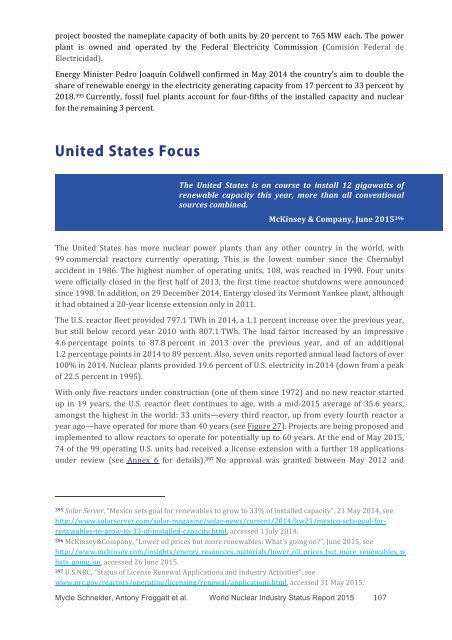PMFA1
PMFA1
PMFA1
You also want an ePaper? Increase the reach of your titles
YUMPU automatically turns print PDFs into web optimized ePapers that Google loves.
project boosted the nameplate capacity of both units by 20 percent to 765 MW each. The powerplant is owned and operated by the Federal Electricity Commission (Comisión Federal deElectricidad).Energy Minister Pedro Joaquín Coldwell confirmed in May 2014 the country’s aim to double theshare of renewable energy in the electricity generating capacity from 17 percent to 33 percent by2018. 395 Currently, fossil fuel plants account for four‐fifths of the installed capacity and nuclearfor the remaining 3 percent.The United States is v on course to install 12 gigawatts ofrenewable capacity this year, more than all conventionalsources combined.McKinsey & Company, June 2015 396The United States has more nuclear power plants than any other country in the world, with99 commercial reactors currently operating. This is the lowest number since the Chernobylaccident in 1986. The highest number of operating units, 108, was reached in 1990. Four unitswere officially closed in the first half of 2013, the first time reactor shutdowns were announcedsince 1998. In addition, on 29 December 2014, Entergy closed its Vermont Yankee plant, althoughit had obtained a 20‐year license extension only in 2011.The U.S. reactor fleet provided 797.1 TWh in 2014, a 1.1 percent increase over the previous year,but still below record year 2010 with 807.1 TWh. The load factor increased by an impressive4.6 percentage points to 87.8 percent in 2013 over the previous year, and of an additional1.2 percentage points in 2014 to 89 percent. Also, seven units reported annual load factors of over100% in 2014. Nuclear plants provided 19.6 percent of U.S. electricity in 2014 (down from a peakof 22.5 percent in 1995).With only five reactors under construction (one of them since 1972) and no new reactor startedup in 19 years, the U.S. reactor fleet continues to age, with a mid‐2015 average of 35.6 years,amongst the highest in the world: 33 units—every third reactor, up from every fourth reactor ayear ago—have operated for more than 40 years (see Figure 27). Projects are being proposed andimplemented to allow reactors to operate for potentially up to 60 years. At the end of May 2015,74 of the 99 operating U.S. units had received a license extension with a further 18 applicationsunder review (see Annex 6 for details). 397 No approval was granted between May 2012 and395 Solar Server, “Mexico sets goal for renewables to grow to 33% of installed capacity”, 21 May 2014, seehttp://www.solarserver.com/solar‐magazine/solar‐news/current/2014/kw21/mexico‐sets‐goal‐forrenewables‐to‐grow‐to‐33‐of‐installed‐capacity.html,accessed 1 July 2014.396 McKinsey&Company, “Lower oil prices but more renewables: What's going on?”, June 2015, seehttp://www.mckinsey.com/insights/energy_resources_materials/lower_oil_prices_but_more_renewables_whats_going_on, accessed 26 June 2015.397 U.S.NRC, “Status of License Renewal Applications and Industry Activities”, seewww.nrc.gov/reactors/operating/licensing/renewal/applications.html, accessed 31 May 2015.Mycle Schneider, Antony Froggatt et al. World Nuclear Industry Status Report 2015 107


